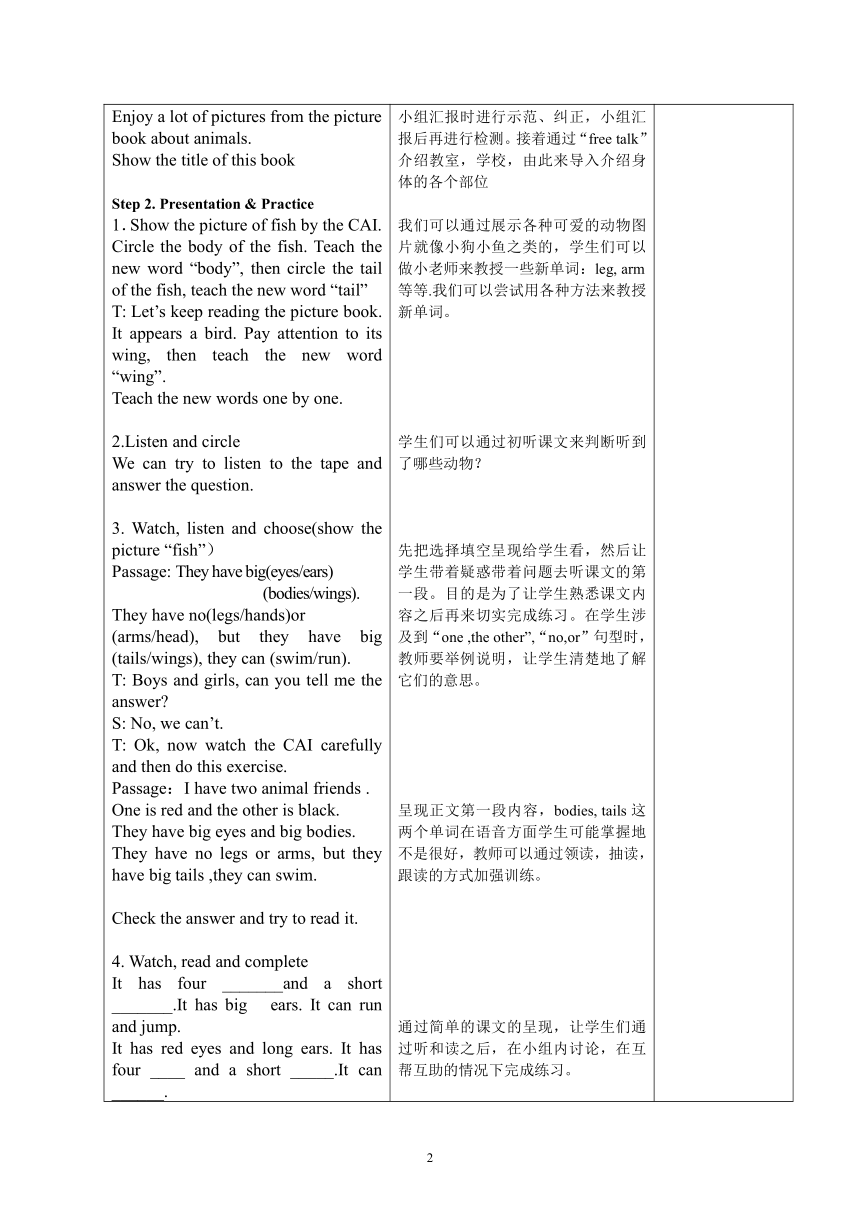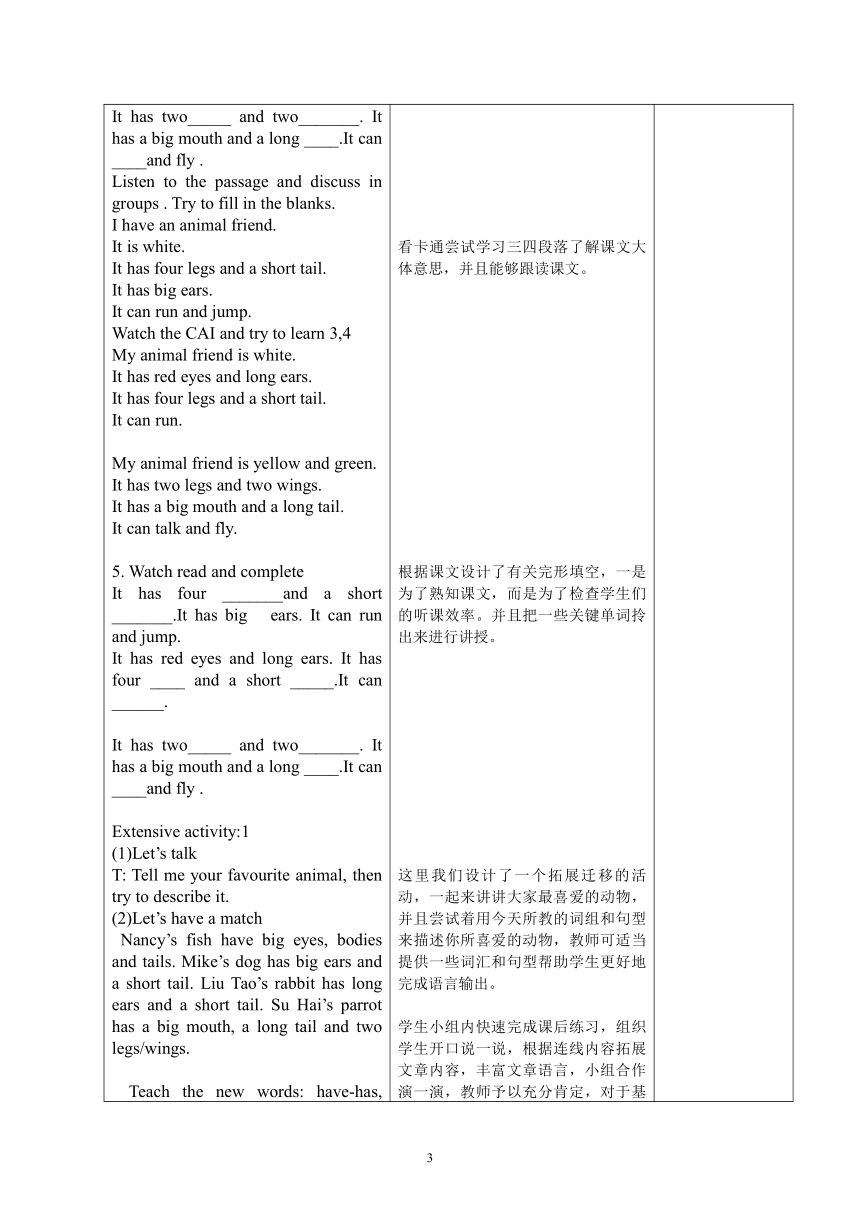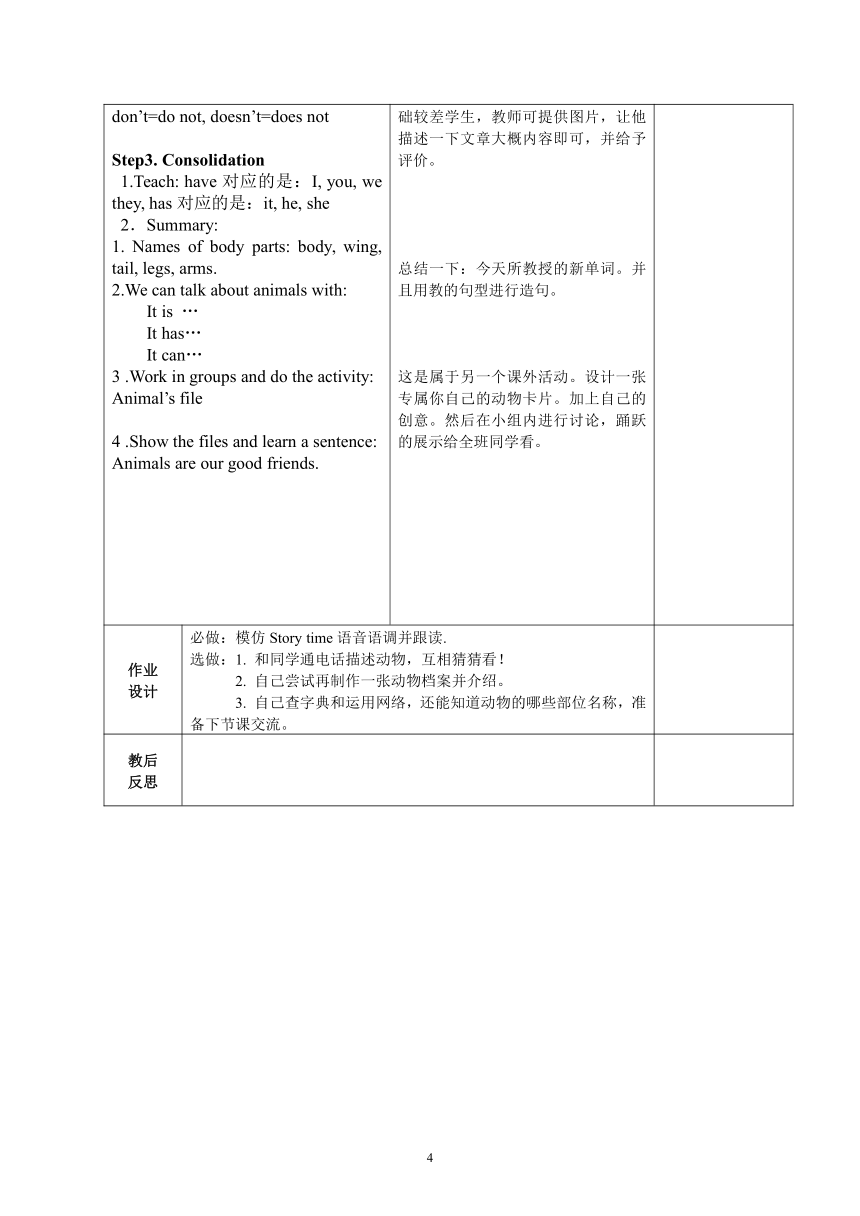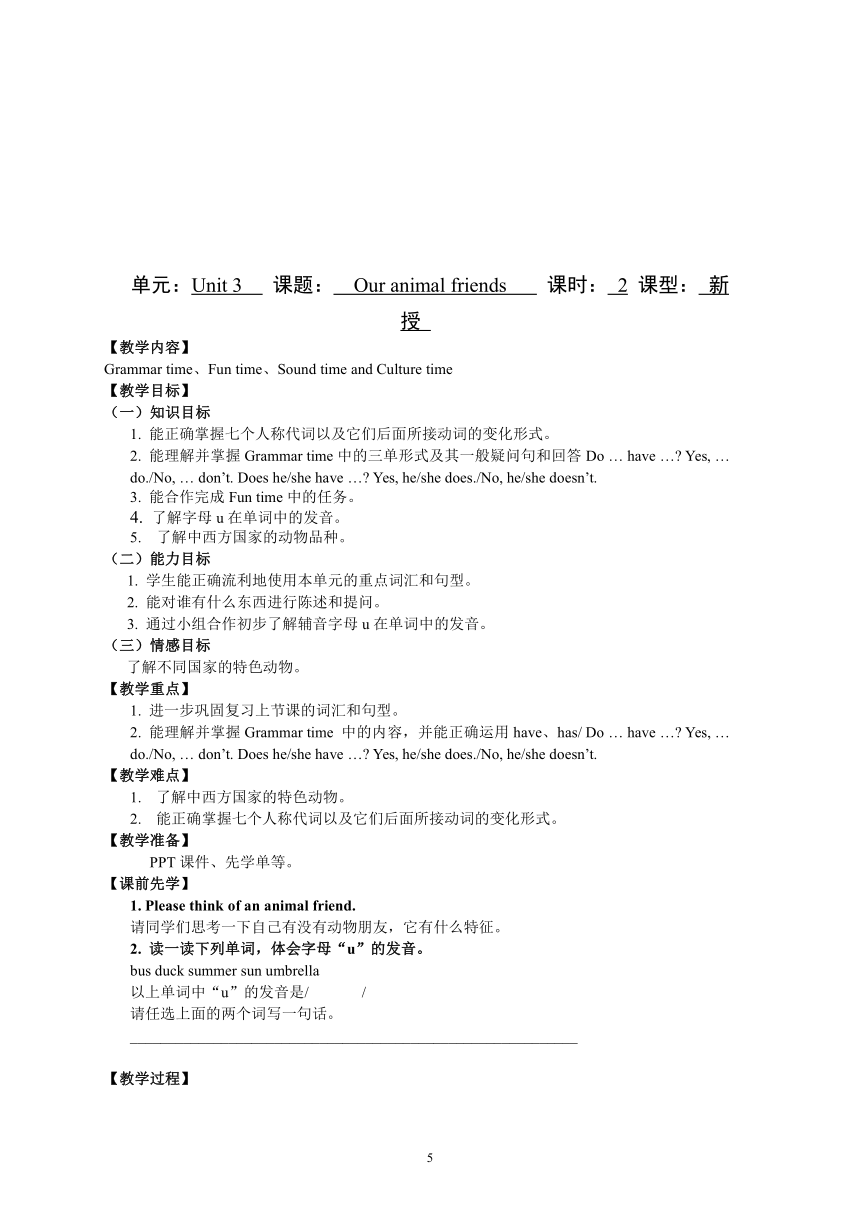Unit 3 Our animal friends Story time 教案
文档属性
| 名称 | Unit 3 Our animal friends Story time 教案 |  | |
| 格式 | docx | ||
| 文件大小 | 38.6KB | ||
| 资源类型 | 教案 | ||
| 版本资源 | 牛津译林版 | ||
| 科目 | 英语 | ||
| 更新时间 | 2021-12-13 21:40:11 | ||
图片预览





文档简介
Unit 3 Our animal friends(教案)
单元:Unit 3 课题: Our animal friends 课时: 1 课型: 新授
【教学目标】
(一)知识目标
1. 能正确地理解、掌握对话内容,并能朗读、初步表演对话
2. 在阅读中学习,通过查阅单词表、字典、猜测词义等方式听懂、会说、会读单词:animal, leg, body, arm, other, tail, wing.
3. 学生能够运用句型:I have animal friends. It’s/They’re …. It/They can .... It has/They have ….
(二)能力目标
1. 能熟练朗读课文内容,掌握新单词,通过阅读来猜测故事中的谜语。
2. 学会有步骤的阅读,掌握阅读的策略。
(三)情感目标
1. 能够在阅读中找寻阅读的乐趣。
培养学生用智慧的双眼去发现动物的可爱之处,同时呼吁他们行动起来,保护动物。
培养学生乐于用英语与伙伴们进行交流的兴趣。
【教学重点】
1. 学习词汇:animal, leg, body, arm, other, tail, wing.
2. 学习句型: I have animal friends. It’s/They’re …. It/They can .... It has/They have ….
【教学难点】
1. 掌握动物的各个组成部分。
2. 将身体的各个部位,通过实际,进行交流运用。
【教学准备】
动物图片,单词卡片,制作动物绘本等
【课前先学】
1. Learn the new words by yourselves.
查字典将Word Bank中的单词的音标写下来,掌握其读音,为小组汇报作准备。
arm / / 手臂 body / /身体 foot / / 脚
leg / /腿 tail/ /尾巴 wing/ / 翅膀
2. Draw one picture of your favourite animals.
用画笔描绘一幅你喜欢的小动物的的画像吧!
3. 选用上面的生词来描绘一下你喜欢的小动物的外貌。
【教学过程】
先 学 预 设 后 教 策 略 二次调整
Step 1. Preparation Greetings and free talk. Check the preparation of the new words. Enjoy a lot of pictures from the picture book about animals. Show the title of this book Step 2. Presentation & Practice 1.Show the picture of fish by the CAI. Circle the body of the fish. Teach the new word “body”, then circle the tail of the fish, teach the new word “tail” T: Let’s keep reading the picture book. It appears a bird. Pay attention to its wing, then teach the new word “wing”. Teach the new words one by one. 2.Listen and circle We can try to listen to the tape and answer the question. 3. Watch, listen and choose(show the picture “fish”) Passage: They have big(eyes/ears) (bodies/wings). They have no(legs/hands)or (arms/head), but they have big (tails/wings), they can (swim/run). T: Boys and girls, can you tell me the answer S: No, we can’t. T: Ok, now watch the CAI carefully and then do this exercise. Passage:I have two animal friends . One is red and the other is black. They have big eyes and big bodies. They have no legs or arms, but they have big tails ,they can swim. Check the answer and try to read it. 4. Watch, read and complete It has four _______and a short _______.It has big ears. It can run and jump. It has red eyes and long ears. It has four ____ and a short _____.It can ______. It has two_____ and two_______. It has a big mouth and a long ____.It can ____and fly . Listen to the passage and discuss in groups . Try to fill in the blanks. I have an animal friend. It is white. It has four legs and a short tail. It has big ears. It can run and jump. Watch the CAI and try to learn 3,4 My animal friend is white. It has red eyes and long ears. It has four legs and a short tail. It can run. My animal friend is yellow and green. It has two legs and two wings. It has a big mouth and a long tail. It can talk and fly. 5. Watch read and complete It has four _______and a short _______.It has big ears. It can run and jump. It has red eyes and long ears. It has four ____ and a short _____.It can ______. It has two_____ and two_______. It has a big mouth and a long ____.It can ____and fly . Extensive activity:1 (1)Let’s talk T: Tell me your favourite animal, then try to describe it. (2)Let’s have a match Nancy’s fish have big eyes, bodies and tails. Mike’s dog has big ears and a short tail. Liu Tao’s rabbit has long ears and a short tail. Su Hai’s parrot has a big mouth, a long tail and two legs/wings. Teach the new words: have-has, don’t=do not, doesn’t=does not Step3. Consolidation 1.Teach: have对应的是:I, you, we they, has对应的是:it, he, she 2.Summary: 1. Names of body parts: body, wing, tail, legs, arms. 2.We can talk about animals with: It is … It has… It can… 3 .Work in groups and do the activity: Animal’s file 4 .Show the files and learn a sentence: Animals are our good friends. 先让学生在小组内进行课前对新单词预习的汇报,接着进行小组预习汇报展示,提醒学生倾听,评价。学生若不能准确读出body,tail的读音,可在小组汇报时进行示范、纠正,小组汇报后再进行检测。接着通过“free talk”介绍教室,学校,由此来导入介绍身体的各个部位 我们可以通过展示各种可爱的动物图片就像小狗小鱼之类的,学生们可以做小老师来教授一些新单词:leg, arm等等.我们可以尝试用各种方法来教授新单词。 学生们可以通过初听课文来判断听到了哪些动物? 先把选择填空呈现给学生看,然后让学生带着疑惑带着问题去听课文的第一段。目的是为了让学生熟悉课文内容之后再来切实完成练习。在学生涉及到“one ,the other”,“no,or”句型时,教师要举例说明,让学生清楚地了解它们的意思。 呈现正文第一段内容,bodies, tails这两个单词在语音方面学生可能掌握地不是很好,教师可以通过领读,抽读,跟读的方式加强训练。 通过简单的课文的呈现,让学生们通过听和读之后,在小组内讨论,在互帮互助的情况下完成练习。 看卡通尝试学习三四段落了解课文大体意思,并且能够跟读课文。 根据课文设计了有关完形填空,一是为了熟知课文,而是为了检查学生们的听课效率。并且把一些关键单词拎出来进行讲授。 这里我们设计了一个拓展迁移的活动,一起来讲讲大家最喜爱的动物,并且尝试着用今天所教的词组和句型来描述你所喜爱的动物,教师可适当提供一些词汇和句型帮助学生更好地完成语言输出。 学生小组内快速完成课后练习,组织学生开口说一说,根据连线内容拓展文章内容,丰富文章语言,小组合作演一演,教师予以充分肯定,对于基础较差学生,教师可提供图片,让他描述一下文章大概内容即可,并给予评价。 总结一下:今天所教授的新单词。并且用教的句型进行造句。 这是属于另一个课外活动。设计一张专属你自己的动物卡片。加上自己的创意。然后在小组内进行讨论,踊跃的展示给全班同学看。
作业 设计 必做:模仿Story time语音语调并跟读. 选做:1. 和同学通电话描述动物,互相猜猜看! 2. 自己尝试再制作一张动物档案并介绍。 3. 自己查字典和运用网络,还能知道动物的哪些部位名称,准 备下节课交流。
教后 反思
单元:Unit 3 课题: Our animal friends 课时: 2 课型: 新授
【教学内容】
Grammar time、Fun time、Sound time and Culture time
【教学目标】
(一)知识目标
1. 能正确掌握七个人称代词以及它们后面所接动词的变化形式。
2. 能理解并掌握Grammar time中的三单形式及其一般疑问句和回答Do … have … Yes, … do./No, … don’t. Does he/she have … Yes, he/she does./No, he/she doesn’t.
3. 能合作完成Fun time中的任务。
4. 了解字母u在单词中的发音。
5. 了解中西方国家的动物品种。
(二)能力目标
1. 学生能正确流利地使用本单元的重点词汇和句型。
2. 能对谁有什么东西进行陈述和提问。
3. 通过小组合作初步了解辅音字母u在单词中的发音。
(三)情感目标
了解不同国家的特色动物。
【教学重点】
1. 进一步巩固复习上节课的词汇和句型。
2. 能理解并掌握Grammar time 中的内容,并能正确运用have、has/ Do … have … Yes, … do./No, … don’t. Does he/she have … Yes, he/she does./No, he/she doesn’t.
【教学难点】
了解中西方国家的特色动物。
能正确掌握七个人称代词以及它们后面所接动词的变化形式。
【教学准备】
PPT课件、先学单等。
【课前先学】
1. Please think of an animal friend.
请同学们思考一下自己有没有动物朋友,它有什么特征。
2. 读一读下列单词,体会字母“u”的发音。
bus duck summer sun umbrella
以上单词中“u”的发音是/ /
请任选上面的两个词写一句话。
___________________________________________________________
【教学过程】
先 学 预 设 后 教 策 略 二次调整
Step 1. Preparation Let’s make a introduction (1) Please introduce your animal friend to us. You can use these sentences: I have… It has/ They have… It/ They can… Step 2. Presentation & Practice Grammar time 阅读两个表格信息,要求个别学生复述表格中句子。 There is a house in the forest. There is some soup on the table. There are three beds in the bedroom. This soup is too hot. The usage of the word “have/ has” You have many animal friends. Can you tell me what do you have What do you have What do they have Can you describe these people?(拿出story time的图,让学生形容谁有什么东西) He has a dog. It has four legs. He has a rabbit. It has four legs. She has a parrot. It has two legs. Fill in the blanks. I have an animal friend,. (改为一般疑问句) ___ ___ have an animal friend 并做肯定和否定回答。 They have an animal friend.(改为一般疑问句并做肯定和否定回答) 仿照上面例句,让学生对不同的对象进行提问。 遇到第三人称单数时要用does提问。 肯定回答Yes, he/ she/ it does. 否定回答No, he/ she/ it doesn’t.. (二) Fun time You all have animal friends. Now, let’s do a survey. You can ask your friends some questions and guess what animal is it. You can use: Do you… Does it… What can it/they do ( 三)Sound time Look and talk: What’s in the picture (出示图片) Can you use these words to make some sentences Look and guess: Does the rubber duck like the sunny weather? What does he like? Listen to the tape and try to find the answers. Follow the tape. Look at these words: rubber/ duck/ but/ sunny/ summer/ sun/ umbrella. What is the letter ‘u’ pronounced /Λ/ Write them down. Let the students say the words. Try to read the new words Cut funny jump hungry cup subject (四)Culture time Your animal friends are so cute, but there are a lot of different animals in the world. Let’s look at the pictures. Teacher introduces these animals: You can see pandas in China. You can see bald eagles in the US. You can see polar bears in Canada. You can see kangaroos in Australia. Step 3. Production Try to say more There are so many different animals in the world, what else do you know about animals. If you don’t know, you can describe one of the animals. 这个环节中是对Story time知识的回顾复习。向同学们介绍你的动物朋友也是检查先学作业的一部分,为后面的部分做铺垫。对于学生可能出现动词的三单形式混淆,教师要做强调补充说明。 这部分可以要求个别学生或者全体学生逐一复述表格。教师可以复述第一个句子。 大部分学生对第一和第二人称的用法比较熟悉,可采用提问的方法一带而过。当然有个别学生可能一二人称都会出现混淆,教师就要适当地引导一下他们。 教师示范一组,然后让学生跟同桌之间来说出另外三幅图的内容,掌握has的用法。第三人称he/ she/ it 后面加has.学生对于课文内容已经熟悉了,在此基础上,师可让学生脱离课文来阐述一下,基本意思到位,教师应当给予肯定和奖励。 在学了三单的基础上学生可能会填Does you,可提示学生注意主语。 老师对学生进行提问,操练肯定回答和否定回答的用法。学生对于does 和 doesn’t 的拼写普遍出错较多,要多强调,加强记忆。 这部分内容要求小组内相互提问完成。要求学生通过提问,获取小动物的体貌特征信息,从而猜测出动物的名字。学生可以自由选择要询问调查的学生,并记录下调查结果。 引导学生尽可能把图片描述完整,把图中的几样事物用自己的话描述出来。第三句话对于学生来说是难点,可出现多一点的关键词。 学生带着问题听录音,找出这两个问题的答案。然后小组内一问一答来校对答案,学生可能不理解weather,when,carries这几个单词,可让他们结合图片来理解。 在总结读音时可以让学生进行小组讨论,并让学生讨论other words have this sound。 组长负责组织讨论,请记录员负责记录,最后请另外的组员汇报结果,同时教师把单词写在黑板上。 此内容是学生较为感兴趣的,教师在给出这几个图片时可以对这几个动物进行一些介绍,如他们的体型特征,它们生活的环境特点等,对学生的知识面进行拓展,从而引出下面的内容。 教师可以适时熏陶,动物是我们的朋友,我们要尽自己的所能来保护动物,特别是一些珍稀动物。
作业 设计 1. Copy the new vocabulary. 2. Read, recite and act this cartoon story.
单元:Unit 3 课题: Our animal friends 课时: 3 课型:新授
【教学目标】
(一)知识目标
1. 能够阅读并理解卡通部分的故事内容
2. 通过查阅字典,单词表等方式,听懂并会读单词give finger
3. 复习并巩固本单元的知识点,熟练运用所学的句型:I have animal friends. It’s /they’re……
It/they can…… He/ She /It has I/We/they have…..
(二)能力目标
1. 能阅读并理解卡通部分的幽默,并能复述故事内容
(三)情感目标
1. 能够在阅读中体验到阅读的乐趣
2. 培养学生能够感觉动物朋友有趣可爱之处,同时培养学生对小动物的同情心
【教学重点】
1. 复习并巩固语法,熟练运用所学的句型:Do ….have… Yes,…do. No,…..don’t.
Does he/she have…. Yes,he/she does. No,he/she doesn’t
2. 复习句型there be结构,并能区分there be与….have/has的用法
3. 掌握字母“u”的发音
【教学难点】
1. 常交际中熟练运用所学的句型
2. 能在教师的引导下客观的对自己的学习情况作出评价
【教学准备】
单词卡片 课文录音等
【课前先学】
1. Learn the new words by yourselves.
查字典将Word Bank中的单词的音标写下来,掌握其读音,为小组汇报作准备。
give finger
2.准备一些动物图片,小组交流用英语说出动物的名字
【教学过程】
先 学 预 设 后 教 策 略 二次调整
Step 1. Preparation Check the preparation of the new words Group work: Talk about the name of the animals . Step 2. Presentation & Practice Take out the pictures and look at the pictures, 1. Please watch the cartoon and discuss 2Read the sentences: It has ten legs. It has eight legs. It has big arms. It has a big body too. 3.Read the cartoon (1) Listen to the tape and notice the pronunciations and intonations. (2) Read after the tape. Choose one kind of reading and read in groups. (3) Read this cartoon story together. (4)Ask and answer Who is their new friend What can the crab do How many legs and arms does it have? How is its body ? Does the crab like cake (5) Read in roles. Step 3. Production (1)Review the grammar of the verb tense forms Words: have-has, don’t=do not, doesn’t=does not. Drills: Do … Yes, … do. No, … don’t. Does … Yes, … does. No, … doesn’t. (2) Review drills: Describe something: Is there … Yes, there is. Are there any … Yes, there are. (3)Review the sound of the letter “u” Say the phonetic /Λ/ of the letter “u”. Find the words with the same sound of the letter “u” Step 4.Checkout time Look at the pictures. Talk about the pictures and describe the animals on the farm. Ask and answer, then fill the forms: Step 5. Describe the animal friends. Read and write the sentences. This is my animal friend. It is …. It has …. It can …. Step 6.Ticking time Review the vocabulary and patterns of this unit. (1)Say the rules of it. (2)Appraise the harvest of this unit. (3)Total the stars. 先让学生在小组里交流对新单词的预习,若学生不能准确读出give finger的读音,可在小组汇报时进行示范纠正。 小组里说说一些动物的名字,复习动物的英语单词,为后面的checkout做好铺垫。学生可能会画一些动物但未必会说动物的英语单词,教师及时补充。 教师可以呈现一个螃蟹的图片,要求学生两人一组讨论螃蟹的体貌特征,为阅读故事做准备。学生可能要问螃蟹的单词怎么读和写,教师进行适当补充 crab并教读。 教师可以用一些简单的问题做适当的导入T:Who are they What are they doing 并要求学生划出含有It has…句型的句子。 教师可设计多样的阅读形式保持学生的兴趣,导入之后可设计以下几个阅读形式: 观察图片,回答老师提出的指导性问题;出示问题,快速浏览以了解文章大意;再次阅读,完成表格以捕捉具体信息。学生们在教师设计的层层递进的阅读活动中,思想高度集中以迎接一个个挑战。在整个阅读过程中,还可以播放一段舒缓的音乐,营造轻松的氛围。由此,学生的阅读兴趣得以充分的保持,为完成阅读后任务奠定了坚实的基础。 在扮演阅读过程中,其余学生进行评价,尤其要纠正读音,有的学生对升降调不太重视,可以让其他学生来纠正。 归纳呈现I/We/They have…. He/ She /It has句型的陈述句和一般疑问句Do you /they have… Does he/she have.. 及其答语。 学生可能对have和has的用法有点模糊,教师可以和学生总结性地回顾七个人称代词以及它们后面所接动词的单复数形式。 学生可能对动词的第三人称单数形式没有印象,教师可以在复习have-has do-does的基础上让学生说说其他动词的第三人称单数形式。 复习there be句型及一般疑问句的回答时,让学生说说there be与. have 和 has两种句型的区别. 在纠正学生读音时,让学生尽可能多地找出已学过的含有音素/Λ/的单词并鼓励学生读出没有学过的含有音素/Λ/的单词。 在操作本活动时可以借助于图片,用There is/are … on the farm. It has/They have先让学生在小组里说说,小组汇报后再检测。 学生可能不能正确使用单词的单复数形式,教师必须及时提醒,同时鼓励学生综合运用以前学过的词汇,如颜色类和形体特征类的词汇:Pink yellow black white grey brown red short fat big short small long tall . 画图时学生可以画自己喜欢的动物,也可以发挥想象画一个想象中的动物或怪物,同桌相互交流,然后让学生上台表演。 通过四人小组评价,打上星星,教师可以检查一些得星数少的学生,让好学生跟差生一对一补差。
作业 设计 1.Describe and write the animal friends. 2.Recite and retell the cartoon. 3.Rever the unit and finish the workbooks.
教后 反思
单元:Unit 3 课题: Our animal friends 课时: 4 课型: 复习
【教学目标】
(一)知识目标
1.了解中国和主要英语国家的特有动物。
2.能正确并熟练地运用本课词句简单介绍动物。
3.通过练习,检测学生对句型 He/She/It has...以及We/They have...的掌握情况,使学生能正确运用。
(二)能力目标
能正确并熟练地运用本课词句简单介绍动物.
(三)情感目标
1. 能够在阅读中找寻阅读的乐趣。
培养学生用智慧的双眼去发现动物的可爱之处,同时呼吁他们行动起来,保护动物。
培养学生乐于用英语与伙伴们进行交流的兴趣。
【教学重难点】
1.能正确并熟练地运用本课词句简单介绍动物。
【教学准备】
动物图片,单词卡片
【教学过程】
先 学 预 设 后 教 策 略 二次调整
Step 1. Preparation Describe your animal friends. S1:I have an animal friend. It has..... Ask some questions about “Animal friends” S2:Does it have... S3:Do you... Step 2. Presentation & Practice Draw and write. Draw an animal and write about it work in groups。 This is my animal friend. It is . It has . It can . Say the animal friend in groups. Look and say. Look the picture and talk about it in groups.Try to say: There’s /There are....on the farm. It has/They have.... Action. S1:There are five pigs on the farm. They’re pink. They’re short and fat. They have big noses, big ears ,big mouths and big bodies. They ....... S2:......... 1.Look at the picture. What animals are they (They are panda ,bald eagles, polar bears and kangaroos.) Teach the new words: bald eagle, polar bear, Canada, kangaroo, Australia. Read “Culture time” in pairs. 教师设计练习来检测学生的理解情况 .Where do pandas come from
2).Where do bald eagles come from
3).Where do polar bears come from
4).Where do kangaroos come from Step3. Consolidation Say something more There are different animals in different countries. Now let’s talk about more animals in China and in Western countries. I can see________ in China, and I can see _______ in the US/Canada/Australia. 让学生在小组内自由的说对话,老师进行巡视指导。 有部分后进生可能对it引导的句子不太熟练,所以老师要关注这部分学生。 让学生分小组写出各自喜欢的动物朋友,发挥小组合作,提优补差。 通过小组讨论交流,让学生正确使用单词的单复数形式,鼓励学生综合运用一起学过的词汇,如颜色和形体特征类的词汇。让学生学会更加熟练的运用Unit1 的There be 句型。教师在指导中注意学生对have和has的使用情况。 通过课前的预习以及老师的引导,有个别优秀的同学可能会说出一些书上没有的动物单词,可以让他们先说一说
作业 设计 1. Draw one about your favorite animal and write about it. 2.Review Unit1
2
单元:Unit 3 课题: Our animal friends 课时: 1 课型: 新授
【教学目标】
(一)知识目标
1. 能正确地理解、掌握对话内容,并能朗读、初步表演对话
2. 在阅读中学习,通过查阅单词表、字典、猜测词义等方式听懂、会说、会读单词:animal, leg, body, arm, other, tail, wing.
3. 学生能够运用句型:I have animal friends. It’s/They’re …. It/They can .... It has/They have ….
(二)能力目标
1. 能熟练朗读课文内容,掌握新单词,通过阅读来猜测故事中的谜语。
2. 学会有步骤的阅读,掌握阅读的策略。
(三)情感目标
1. 能够在阅读中找寻阅读的乐趣。
培养学生用智慧的双眼去发现动物的可爱之处,同时呼吁他们行动起来,保护动物。
培养学生乐于用英语与伙伴们进行交流的兴趣。
【教学重点】
1. 学习词汇:animal, leg, body, arm, other, tail, wing.
2. 学习句型: I have animal friends. It’s/They’re …. It/They can .... It has/They have ….
【教学难点】
1. 掌握动物的各个组成部分。
2. 将身体的各个部位,通过实际,进行交流运用。
【教学准备】
动物图片,单词卡片,制作动物绘本等
【课前先学】
1. Learn the new words by yourselves.
查字典将Word Bank中的单词的音标写下来,掌握其读音,为小组汇报作准备。
arm / / 手臂 body / /身体 foot / / 脚
leg / /腿 tail/ /尾巴 wing/ / 翅膀
2. Draw one picture of your favourite animals.
用画笔描绘一幅你喜欢的小动物的的画像吧!
3. 选用上面的生词来描绘一下你喜欢的小动物的外貌。
【教学过程】
先 学 预 设 后 教 策 略 二次调整
Step 1. Preparation Greetings and free talk. Check the preparation of the new words. Enjoy a lot of pictures from the picture book about animals. Show the title of this book Step 2. Presentation & Practice 1.Show the picture of fish by the CAI. Circle the body of the fish. Teach the new word “body”, then circle the tail of the fish, teach the new word “tail” T: Let’s keep reading the picture book. It appears a bird. Pay attention to its wing, then teach the new word “wing”. Teach the new words one by one. 2.Listen and circle We can try to listen to the tape and answer the question. 3. Watch, listen and choose(show the picture “fish”) Passage: They have big(eyes/ears) (bodies/wings). They have no(legs/hands)or (arms/head), but they have big (tails/wings), they can (swim/run). T: Boys and girls, can you tell me the answer S: No, we can’t. T: Ok, now watch the CAI carefully and then do this exercise. Passage:I have two animal friends . One is red and the other is black. They have big eyes and big bodies. They have no legs or arms, but they have big tails ,they can swim. Check the answer and try to read it. 4. Watch, read and complete It has four _______and a short _______.It has big ears. It can run and jump. It has red eyes and long ears. It has four ____ and a short _____.It can ______. It has two_____ and two_______. It has a big mouth and a long ____.It can ____and fly . Listen to the passage and discuss in groups . Try to fill in the blanks. I have an animal friend. It is white. It has four legs and a short tail. It has big ears. It can run and jump. Watch the CAI and try to learn 3,4 My animal friend is white. It has red eyes and long ears. It has four legs and a short tail. It can run. My animal friend is yellow and green. It has two legs and two wings. It has a big mouth and a long tail. It can talk and fly. 5. Watch read and complete It has four _______and a short _______.It has big ears. It can run and jump. It has red eyes and long ears. It has four ____ and a short _____.It can ______. It has two_____ and two_______. It has a big mouth and a long ____.It can ____and fly . Extensive activity:1 (1)Let’s talk T: Tell me your favourite animal, then try to describe it. (2)Let’s have a match Nancy’s fish have big eyes, bodies and tails. Mike’s dog has big ears and a short tail. Liu Tao’s rabbit has long ears and a short tail. Su Hai’s parrot has a big mouth, a long tail and two legs/wings. Teach the new words: have-has, don’t=do not, doesn’t=does not Step3. Consolidation 1.Teach: have对应的是:I, you, we they, has对应的是:it, he, she 2.Summary: 1. Names of body parts: body, wing, tail, legs, arms. 2.We can talk about animals with: It is … It has… It can… 3 .Work in groups and do the activity: Animal’s file 4 .Show the files and learn a sentence: Animals are our good friends. 先让学生在小组内进行课前对新单词预习的汇报,接着进行小组预习汇报展示,提醒学生倾听,评价。学生若不能准确读出body,tail的读音,可在小组汇报时进行示范、纠正,小组汇报后再进行检测。接着通过“free talk”介绍教室,学校,由此来导入介绍身体的各个部位 我们可以通过展示各种可爱的动物图片就像小狗小鱼之类的,学生们可以做小老师来教授一些新单词:leg, arm等等.我们可以尝试用各种方法来教授新单词。 学生们可以通过初听课文来判断听到了哪些动物? 先把选择填空呈现给学生看,然后让学生带着疑惑带着问题去听课文的第一段。目的是为了让学生熟悉课文内容之后再来切实完成练习。在学生涉及到“one ,the other”,“no,or”句型时,教师要举例说明,让学生清楚地了解它们的意思。 呈现正文第一段内容,bodies, tails这两个单词在语音方面学生可能掌握地不是很好,教师可以通过领读,抽读,跟读的方式加强训练。 通过简单的课文的呈现,让学生们通过听和读之后,在小组内讨论,在互帮互助的情况下完成练习。 看卡通尝试学习三四段落了解课文大体意思,并且能够跟读课文。 根据课文设计了有关完形填空,一是为了熟知课文,而是为了检查学生们的听课效率。并且把一些关键单词拎出来进行讲授。 这里我们设计了一个拓展迁移的活动,一起来讲讲大家最喜爱的动物,并且尝试着用今天所教的词组和句型来描述你所喜爱的动物,教师可适当提供一些词汇和句型帮助学生更好地完成语言输出。 学生小组内快速完成课后练习,组织学生开口说一说,根据连线内容拓展文章内容,丰富文章语言,小组合作演一演,教师予以充分肯定,对于基础较差学生,教师可提供图片,让他描述一下文章大概内容即可,并给予评价。 总结一下:今天所教授的新单词。并且用教的句型进行造句。 这是属于另一个课外活动。设计一张专属你自己的动物卡片。加上自己的创意。然后在小组内进行讨论,踊跃的展示给全班同学看。
作业 设计 必做:模仿Story time语音语调并跟读. 选做:1. 和同学通电话描述动物,互相猜猜看! 2. 自己尝试再制作一张动物档案并介绍。 3. 自己查字典和运用网络,还能知道动物的哪些部位名称,准 备下节课交流。
教后 反思
单元:Unit 3 课题: Our animal friends 课时: 2 课型: 新授
【教学内容】
Grammar time、Fun time、Sound time and Culture time
【教学目标】
(一)知识目标
1. 能正确掌握七个人称代词以及它们后面所接动词的变化形式。
2. 能理解并掌握Grammar time中的三单形式及其一般疑问句和回答Do … have … Yes, … do./No, … don’t. Does he/she have … Yes, he/she does./No, he/she doesn’t.
3. 能合作完成Fun time中的任务。
4. 了解字母u在单词中的发音。
5. 了解中西方国家的动物品种。
(二)能力目标
1. 学生能正确流利地使用本单元的重点词汇和句型。
2. 能对谁有什么东西进行陈述和提问。
3. 通过小组合作初步了解辅音字母u在单词中的发音。
(三)情感目标
了解不同国家的特色动物。
【教学重点】
1. 进一步巩固复习上节课的词汇和句型。
2. 能理解并掌握Grammar time 中的内容,并能正确运用have、has/ Do … have … Yes, … do./No, … don’t. Does he/she have … Yes, he/she does./No, he/she doesn’t.
【教学难点】
了解中西方国家的特色动物。
能正确掌握七个人称代词以及它们后面所接动词的变化形式。
【教学准备】
PPT课件、先学单等。
【课前先学】
1. Please think of an animal friend.
请同学们思考一下自己有没有动物朋友,它有什么特征。
2. 读一读下列单词,体会字母“u”的发音。
bus duck summer sun umbrella
以上单词中“u”的发音是/ /
请任选上面的两个词写一句话。
___________________________________________________________
【教学过程】
先 学 预 设 后 教 策 略 二次调整
Step 1. Preparation Let’s make a introduction (1) Please introduce your animal friend to us. You can use these sentences: I have… It has/ They have… It/ They can… Step 2. Presentation & Practice Grammar time 阅读两个表格信息,要求个别学生复述表格中句子。 There is a house in the forest. There is some soup on the table. There are three beds in the bedroom. This soup is too hot. The usage of the word “have/ has” You have many animal friends. Can you tell me what do you have What do you have What do they have Can you describe these people?(拿出story time的图,让学生形容谁有什么东西) He has a dog. It has four legs. He has a rabbit. It has four legs. She has a parrot. It has two legs. Fill in the blanks. I have an animal friend,. (改为一般疑问句) ___ ___ have an animal friend 并做肯定和否定回答。 They have an animal friend.(改为一般疑问句并做肯定和否定回答) 仿照上面例句,让学生对不同的对象进行提问。 遇到第三人称单数时要用does提问。 肯定回答Yes, he/ she/ it does. 否定回答No, he/ she/ it doesn’t.. (二) Fun time You all have animal friends. Now, let’s do a survey. You can ask your friends some questions and guess what animal is it. You can use: Do you… Does it… What can it/they do ( 三)Sound time Look and talk: What’s in the picture (出示图片) Can you use these words to make some sentences Look and guess: Does the rubber duck like the sunny weather? What does he like? Listen to the tape and try to find the answers. Follow the tape. Look at these words: rubber/ duck/ but/ sunny/ summer/ sun/ umbrella. What is the letter ‘u’ pronounced /Λ/ Write them down. Let the students say the words. Try to read the new words Cut funny jump hungry cup subject (四)Culture time Your animal friends are so cute, but there are a lot of different animals in the world. Let’s look at the pictures. Teacher introduces these animals: You can see pandas in China. You can see bald eagles in the US. You can see polar bears in Canada. You can see kangaroos in Australia. Step 3. Production Try to say more There are so many different animals in the world, what else do you know about animals. If you don’t know, you can describe one of the animals. 这个环节中是对Story time知识的回顾复习。向同学们介绍你的动物朋友也是检查先学作业的一部分,为后面的部分做铺垫。对于学生可能出现动词的三单形式混淆,教师要做强调补充说明。 这部分可以要求个别学生或者全体学生逐一复述表格。教师可以复述第一个句子。 大部分学生对第一和第二人称的用法比较熟悉,可采用提问的方法一带而过。当然有个别学生可能一二人称都会出现混淆,教师就要适当地引导一下他们。 教师示范一组,然后让学生跟同桌之间来说出另外三幅图的内容,掌握has的用法。第三人称he/ she/ it 后面加has.学生对于课文内容已经熟悉了,在此基础上,师可让学生脱离课文来阐述一下,基本意思到位,教师应当给予肯定和奖励。 在学了三单的基础上学生可能会填Does you,可提示学生注意主语。 老师对学生进行提问,操练肯定回答和否定回答的用法。学生对于does 和 doesn’t 的拼写普遍出错较多,要多强调,加强记忆。 这部分内容要求小组内相互提问完成。要求学生通过提问,获取小动物的体貌特征信息,从而猜测出动物的名字。学生可以自由选择要询问调查的学生,并记录下调查结果。 引导学生尽可能把图片描述完整,把图中的几样事物用自己的话描述出来。第三句话对于学生来说是难点,可出现多一点的关键词。 学生带着问题听录音,找出这两个问题的答案。然后小组内一问一答来校对答案,学生可能不理解weather,when,carries这几个单词,可让他们结合图片来理解。 在总结读音时可以让学生进行小组讨论,并让学生讨论other words have this sound。 组长负责组织讨论,请记录员负责记录,最后请另外的组员汇报结果,同时教师把单词写在黑板上。 此内容是学生较为感兴趣的,教师在给出这几个图片时可以对这几个动物进行一些介绍,如他们的体型特征,它们生活的环境特点等,对学生的知识面进行拓展,从而引出下面的内容。 教师可以适时熏陶,动物是我们的朋友,我们要尽自己的所能来保护动物,特别是一些珍稀动物。
作业 设计 1. Copy the new vocabulary. 2. Read, recite and act this cartoon story.
单元:Unit 3 课题: Our animal friends 课时: 3 课型:新授
【教学目标】
(一)知识目标
1. 能够阅读并理解卡通部分的故事内容
2. 通过查阅字典,单词表等方式,听懂并会读单词give finger
3. 复习并巩固本单元的知识点,熟练运用所学的句型:I have animal friends. It’s /they’re……
It/they can…… He/ She /It has I/We/they have…..
(二)能力目标
1. 能阅读并理解卡通部分的幽默,并能复述故事内容
(三)情感目标
1. 能够在阅读中体验到阅读的乐趣
2. 培养学生能够感觉动物朋友有趣可爱之处,同时培养学生对小动物的同情心
【教学重点】
1. 复习并巩固语法,熟练运用所学的句型:Do ….have… Yes,…do. No,…..don’t.
Does he/she have…. Yes,he/she does. No,he/she doesn’t
2. 复习句型there be结构,并能区分there be与….have/has的用法
3. 掌握字母“u”的发音
【教学难点】
1. 常交际中熟练运用所学的句型
2. 能在教师的引导下客观的对自己的学习情况作出评价
【教学准备】
单词卡片 课文录音等
【课前先学】
1. Learn the new words by yourselves.
查字典将Word Bank中的单词的音标写下来,掌握其读音,为小组汇报作准备。
give finger
2.准备一些动物图片,小组交流用英语说出动物的名字
【教学过程】
先 学 预 设 后 教 策 略 二次调整
Step 1. Preparation Check the preparation of the new words Group work: Talk about the name of the animals . Step 2. Presentation & Practice Take out the pictures and look at the pictures, 1. Please watch the cartoon and discuss 2Read the sentences: It has ten legs. It has eight legs. It has big arms. It has a big body too. 3.Read the cartoon (1) Listen to the tape and notice the pronunciations and intonations. (2) Read after the tape. Choose one kind of reading and read in groups. (3) Read this cartoon story together. (4)Ask and answer Who is their new friend What can the crab do How many legs and arms does it have? How is its body ? Does the crab like cake (5) Read in roles. Step 3. Production (1)Review the grammar of the verb tense forms Words: have-has, don’t=do not, doesn’t=does not. Drills: Do … Yes, … do. No, … don’t. Does … Yes, … does. No, … doesn’t. (2) Review drills: Describe something: Is there … Yes, there is. Are there any … Yes, there are. (3)Review the sound of the letter “u” Say the phonetic /Λ/ of the letter “u”. Find the words with the same sound of the letter “u” Step 4.Checkout time Look at the pictures. Talk about the pictures and describe the animals on the farm. Ask and answer, then fill the forms: Step 5. Describe the animal friends. Read and write the sentences. This is my animal friend. It is …. It has …. It can …. Step 6.Ticking time Review the vocabulary and patterns of this unit. (1)Say the rules of it. (2)Appraise the harvest of this unit. (3)Total the stars. 先让学生在小组里交流对新单词的预习,若学生不能准确读出give finger的读音,可在小组汇报时进行示范纠正。 小组里说说一些动物的名字,复习动物的英语单词,为后面的checkout做好铺垫。学生可能会画一些动物但未必会说动物的英语单词,教师及时补充。 教师可以呈现一个螃蟹的图片,要求学生两人一组讨论螃蟹的体貌特征,为阅读故事做准备。学生可能要问螃蟹的单词怎么读和写,教师进行适当补充 crab并教读。 教师可以用一些简单的问题做适当的导入T:Who are they What are they doing 并要求学生划出含有It has…句型的句子。 教师可设计多样的阅读形式保持学生的兴趣,导入之后可设计以下几个阅读形式: 观察图片,回答老师提出的指导性问题;出示问题,快速浏览以了解文章大意;再次阅读,完成表格以捕捉具体信息。学生们在教师设计的层层递进的阅读活动中,思想高度集中以迎接一个个挑战。在整个阅读过程中,还可以播放一段舒缓的音乐,营造轻松的氛围。由此,学生的阅读兴趣得以充分的保持,为完成阅读后任务奠定了坚实的基础。 在扮演阅读过程中,其余学生进行评价,尤其要纠正读音,有的学生对升降调不太重视,可以让其他学生来纠正。 归纳呈现I/We/They have…. He/ She /It has句型的陈述句和一般疑问句Do you /they have… Does he/she have.. 及其答语。 学生可能对have和has的用法有点模糊,教师可以和学生总结性地回顾七个人称代词以及它们后面所接动词的单复数形式。 学生可能对动词的第三人称单数形式没有印象,教师可以在复习have-has do-does的基础上让学生说说其他动词的第三人称单数形式。 复习there be句型及一般疑问句的回答时,让学生说说there be与. have 和 has两种句型的区别. 在纠正学生读音时,让学生尽可能多地找出已学过的含有音素/Λ/的单词并鼓励学生读出没有学过的含有音素/Λ/的单词。 在操作本活动时可以借助于图片,用There is/are … on the farm. It has/They have先让学生在小组里说说,小组汇报后再检测。 学生可能不能正确使用单词的单复数形式,教师必须及时提醒,同时鼓励学生综合运用以前学过的词汇,如颜色类和形体特征类的词汇:Pink yellow black white grey brown red short fat big short small long tall . 画图时学生可以画自己喜欢的动物,也可以发挥想象画一个想象中的动物或怪物,同桌相互交流,然后让学生上台表演。 通过四人小组评价,打上星星,教师可以检查一些得星数少的学生,让好学生跟差生一对一补差。
作业 设计 1.Describe and write the animal friends. 2.Recite and retell the cartoon. 3.Rever the unit and finish the workbooks.
教后 反思
单元:Unit 3 课题: Our animal friends 课时: 4 课型: 复习
【教学目标】
(一)知识目标
1.了解中国和主要英语国家的特有动物。
2.能正确并熟练地运用本课词句简单介绍动物。
3.通过练习,检测学生对句型 He/She/It has...以及We/They have...的掌握情况,使学生能正确运用。
(二)能力目标
能正确并熟练地运用本课词句简单介绍动物.
(三)情感目标
1. 能够在阅读中找寻阅读的乐趣。
培养学生用智慧的双眼去发现动物的可爱之处,同时呼吁他们行动起来,保护动物。
培养学生乐于用英语与伙伴们进行交流的兴趣。
【教学重难点】
1.能正确并熟练地运用本课词句简单介绍动物。
【教学准备】
动物图片,单词卡片
【教学过程】
先 学 预 设 后 教 策 略 二次调整
Step 1. Preparation Describe your animal friends. S1:I have an animal friend. It has..... Ask some questions about “Animal friends” S2:Does it have... S3:Do you... Step 2. Presentation & Practice Draw and write. Draw an animal and write about it work in groups。 This is my animal friend. It is . It has . It can . Say the animal friend in groups. Look and say. Look the picture and talk about it in groups.Try to say: There’s /There are....on the farm. It has/They have.... Action. S1:There are five pigs on the farm. They’re pink. They’re short and fat. They have big noses, big ears ,big mouths and big bodies. They ....... S2:......... 1.Look at the picture. What animals are they (They are panda ,bald eagles, polar bears and kangaroos.) Teach the new words: bald eagle, polar bear, Canada, kangaroo, Australia. Read “Culture time” in pairs. 教师设计练习来检测学生的理解情况 .Where do pandas come from
2).Where do bald eagles come from
3).Where do polar bears come from
4).Where do kangaroos come from Step3. Consolidation Say something more There are different animals in different countries. Now let’s talk about more animals in China and in Western countries. I can see________ in China, and I can see _______ in the US/Canada/Australia. 让学生在小组内自由的说对话,老师进行巡视指导。 有部分后进生可能对it引导的句子不太熟练,所以老师要关注这部分学生。 让学生分小组写出各自喜欢的动物朋友,发挥小组合作,提优补差。 通过小组讨论交流,让学生正确使用单词的单复数形式,鼓励学生综合运用一起学过的词汇,如颜色和形体特征类的词汇。让学生学会更加熟练的运用Unit1 的There be 句型。教师在指导中注意学生对have和has的使用情况。 通过课前的预习以及老师的引导,有个别优秀的同学可能会说出一些书上没有的动物单词,可以让他们先说一说
作业 设计 1. Draw one about your favorite animal and write about it. 2.Review Unit1
2
